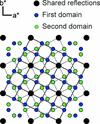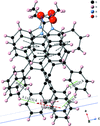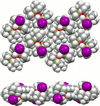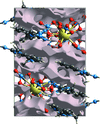issue contents
June 2022 issue

Cover illustration: Lanthanum telluride (LaTe1.9) crystals are twinned by reticular merohedry with twin index 5. The resulting layered structure is a tenfold (×
×2) superstructure of stacked, puckered LaTe slabs interspersed with planar Te-deficient layers. See: Poddig & Doert [Acta Cryst. (2022). E78, 559–562].
Jerry P. Jasinski tribute
Download citation


Download citation


The reaction of [Cu(CH3CN)4](BF4) with 1-methyl-1,3-imidazolidine-2-thione {SC3H4(NMe) NH} forms the one-dimensional coordination polymer [Cu4(κ5:L1—N—S—N—L1)2(κ1:L1—NH)2(κ2: L1—NH)2]n(BF4)4n {L1 = SC3H4(NMe)NH} with sulfur-bridged {CuI4S10}n central cores.
CCDC reference: 2150195
research communications
Download citation


Download citation


The crystal structures of two RuII complexes bearing a tridentate polypyridine ligand and N-coordinating thiocyanato ligands at the axial or equatorial position are compared.
Download citation


Download citation


The crystal structure of the `magic' mushroom natural product baeocystin is reported for the first time.
CCDC reference: 2169087
Download citation


Download citation


Intermolecular N—H⋯O, C—H⋯O and C—H⋯N hydrogen bonds form a three-dimensional network in the crystal, connecting molecules through the O atoms of solvent molecules.
CCDC reference: 2170241
Download citation


Download citation


The crystal structure of LaTe1.9 (CeSe1.9 structure type; space group P42/n) was determined from a twinned crystal. LaTe1.9 features puckered [LaTe] slabs and planar [Te] layers consisting of Te22− and Te2− anions.
CCDC reference: 2170854
Download citation


Download citation


The asymmetric unit contains two independent molecules having opposite conformations and each forming self-dimers through complementary O—H⋯O hydrogen bonds. These dimers are linked by weak C—H⋯π interactions involving the phenyl ring and the olefinic double bond into zigzag chains extending along the c-axis direction. The chains are linked by C—H⋯O hydrogen bonds to form the full three-dimensional structure in which one can discern layers parallel to the bc plane.
CCDC reference: 2170436
Download citation


Download citation


In the crystal, O—H⋯O, C—H⋯O, and C—H⋯N hydrogen bonds connect molecules, generating molecular layers parallel to (100). These layers are linked together by weak C—H⋯π interactions and van der Waals forces.
CCDC reference: 2170547
Download citation


Download citation


The main intermolecular interactions in the two title salts are O⋯H/H⋯O contacts, as revealed by Hirshfeld surface analyses.
Download citation


Download citation


A new ordered C2/c model is proposed for the dimetal terephthalate dihydroxides M = Co, Ni, and Zn, compared to the previous disordered C2/m model for M = Co.
Download citation


Download citation


A dual emissive fluorescent substituted benzo[def]carbazole was obtained through C—H bond activation catalysed by Pd(OAc)2. It crystallizes in the monoclinic space group P21/n.
CCDC reference: 2101657
Download citation


Download citation


The crystal structures of anhydrous N-benzylcinchonidinium bromide and the sesquihydrate are reported. O—H hydrogen-bond donor interactions and numerous C—H⋯Br contacts dominate the intermolecular features.
Download citation


Download citation


Hydrogen bonding links the donor alcohol functional groups of two 2-tert-butyl-4-methylphenol molecules to the central acceptor polyamine aminal cage TATD yielding the three molecule adduct, half of which comprises the asymmetric unit in this crystal structure.
CCDC reference: 2092229
Download citation


Download citation


Molecules in the crystal are joined together by C—H—O hydrogen bonds, forming a three-dimensional network
CCDC reference: 2171930
Download citation


Download citation


By an oxidative synthesis in aqueous trifluoroacetic acid, the mixed ammonium/oxonium crystalline solid [(NH4)1–x(H3O)x]2[Yb6F8(O2CCF3)12(H2O)4]·4H2O is obtained from ytterbium(II) trifluoroacetate. It is the first example of a substance containing an octahedro-hexanuclear ytterbium(III) complex with μ3-face-capping fluorido ligands and comprises an unusual kind of substitutional disorder. The effects of the disordered cation position on the coordination of additional O,O′-bridging carboxylato and aqua ligands are discussed in detail.
CCDC reference: 2170493
Download citation


Download citation


Potassium orthoselenate(IV), K2SeO3, crystallizes isostructural with Na2SO3 and K2TeO3 in the trigonal space group P![[\overline{3}]](/e/issues/2022/06/00/wm5645/teximages/wm5645fi1.svg) with lattice parameters a = 6.1063 (4) Å and c = 6.9242 (4) Å at 100 K.
with lattice parameters a = 6.1063 (4) Å and c = 6.9242 (4) Å at 100 K.
CCDC reference: 2172487
Download citation


Download citation


The title compounds show different packing motifs including chains mediated by N—H⋯N and N—H⋯O hydrogen bonds.
Download citation


Download citation


The coordination polyhedra of the zinc(II) ions in the complex cation and the anion of the title compound, viz. trans-ZnN4O2, are distorted octahedra. In the crystal, the hydrogen-bonding interactions between the N—H groups of the tetraamine, the acidic groups of the anion and coordinated water molecules result in formation of one-dimensional tapes running along the [1![[\overline{1}]](/e/issues/2022/06/00/hb8017/teximages/hb8017fi1.svg) 0] direction, which are further arranged in sheets lying parallel to the (001) plane.
0] direction, which are further arranged in sheets lying parallel to the (001) plane.
CCDC reference: 2166638
Download citation


Download citation


The structure of a mono-amine PdII complex is reported in which the Pd—NH2 length is slightly shorter than the observed mean value for other complexes involving Pd attached to the nitrogen of an aniline derivative.
CCDC reference: 2171669
Download citation


Download citation


The crystal structure of di-tert-butylhydroxidoiodidotin(IV), [Sn(C4H9)2I(OH)] or tBu2Sn(OH)I, consists of centrosymmetric dimers exhibiting the characteristic structural features of diorganotin(IV)-hydroxide-halides.
CCDC reference: 2172420
Download citation


Download citation


Both six-membered rings of the fused heterocyclic system of the title compound display envelope conformations. Two hydrogen bonds involving the amino group lead to a double-layer structure.
CCDC reference: 2172530
Download citation


Download citation


The title compound, isolated from the Chloranthus japonicus Sieb., is a typical lindenane-type sesquiterpenoid. Hirshfeld surface analysis illustrates that the most important contributions are from O⋯H/H⋯O contacts (34.6%).
CCDC reference: 2169817
Download citation


Download citation


The title hybrid lanthanum complex comprises an icosahedrally arranged La(NO3)6]3– anion that is linked to the organic C8H10N3+ cations through N—H⋯O and C—H⋯O interactions.
CCDC reference: 2132821
Download citation


Download citation


Two new crystalline salts, namely, hypoxanthinium bromide monohydrate, C5H5N4O+·Br−·H2O (I) and xanthinium bromide monohydrate, C5H5N4O2+·Br−·H2O (II), were synthesized and characterized by single-crystal X-ray diffraction technique and Hirshfeld surface analysis. The hypoxanthinium and xanthinium cations in salts I and II are both in the oxo-N(9)–H tautomeric form. The crystal packing of the two salts is governed predominantly by N—H⋯O, N—H⋯Br, C—H⋯Br and O—H⋯Br interactions described by ![[R_{3}^{2}]](/e/issues/2022/06/00/jq2017/teximages/jq2017fi1.svg) (9) and
(9) and ![[R_{2}^{2}]](/e/issues/2022/06/00/jq2017/teximages/jq2017fi2.svg) (8) synthons.
(8) synthons.
Download citation


Download citation


The title compound [Ni(H2O)6](PHB)2(H2O)2 (PHB = 4-hydroxybenzoate, C7H5O3), isostructural with the Mg, Co and Mn complexes, was obtained by the reaction of NiCl2, 4-hydroxybenzoic acid (PHBA) and monoethanolamine in aqueous ethanol solution.
CCDC reference: 2131925
Download citation


Download citation


One of the 1,3-dihydro-2H-indol-2-one units is in an axial position, while the other is in a bisectional position relative to the central five-membered cyclopentene ring. The methyl methanimidate unit is in an equatorial position. The crystal structure is consolidated by intermolecular N—H⋯N, N—H⋯O and C—H⋯O hydrogen bonding, forming a three-dimensional network.
CCDC reference: 2173900
Download citation


Download citation


In the crystal, hydrogen-bonding interactions between the 2,4,6-triaminopyrimidine cation and the nitrate anions lead to a one-dimensional supramolecular network with weak anionic interactions forming a three-dimensional network. Energy framework analysis showed that of the components of the framework energies, electrostatic repulsion (Erep) is dominant.
CCDC reference: 2173730
Download citation


Download citation


In the title compound, the dihedral angles between the thiazole ring and its attached chlorophenyl and phenyl rings are 13.12 (14) and 43.79 (14)°, respectively.
CCDC reference: 2174374
Download citation


Download citation


In the title molecular complex, the molecules form stacks consisting of aggregates with disordered 1-aminopyrene molecule surrounded by two 4,6-diacetylresorcinol molecules. Neighbouring stacks are linked by hydrogen bonds between the amine H atoms of the 1-aminopyrene molecule with the adjacent carbonyl oxygen atom of the 4,6-diacetylresorcinol molecule.
CCDC reference: 2174187


 journal menu
journal menu














































